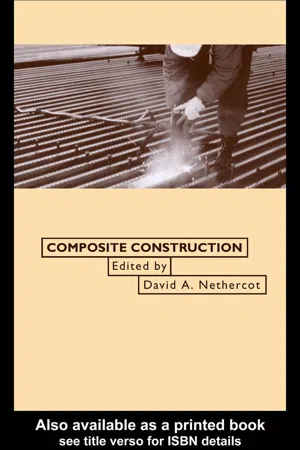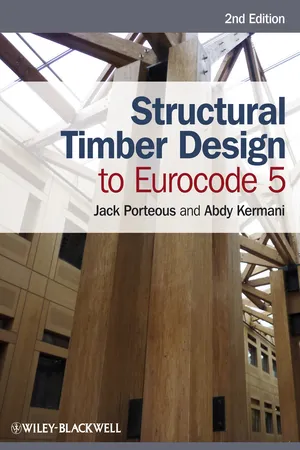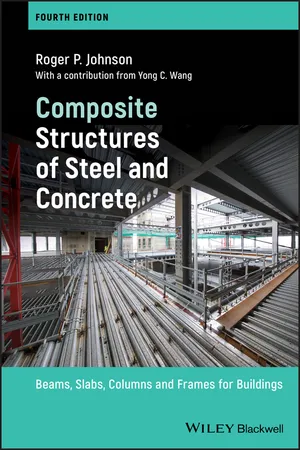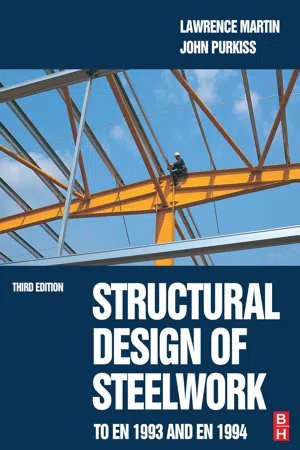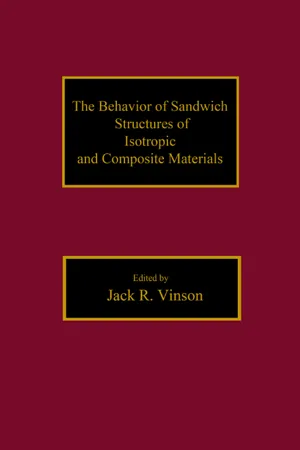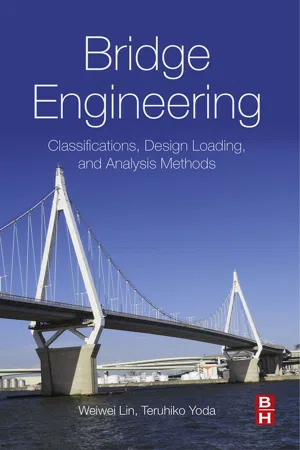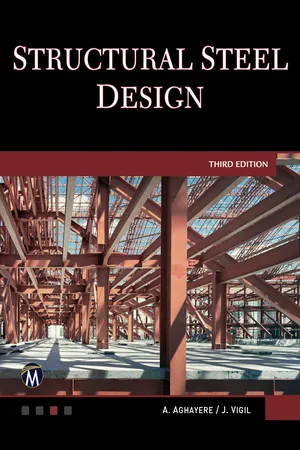Technology & Engineering
Composite Beam Sections
Composite beam sections are structural elements made by combining different materials, such as steel and concrete, to create a more efficient and versatile beam. By utilizing the strengths of each material, composite beam sections can achieve greater load-carrying capacity and stiffness compared to traditional beams. This makes them a popular choice in construction for supporting heavy loads over long spans.
Written by Perlego with AI-assistance
Related key terms
11 Key excerpts on "Composite Beam Sections"
- eBook - ePub
- David Nethercot, David Nethercot(Authors)
- 2003(Publication Date)
- CRC Press(Publisher)
CHAPTER TWO: Composite BeamsHoward D. Wright
2.1 INTRODUCTION
Composite beams may well be the most common form of composite element in steel frame building construction and have been the major form for mid range steel bridges. As the main criterion for design is flexure, the study of composite beams provides an explanation to the associated behaviour of many other composite elements such as composite slabs, composite columns subject to lateral loads and composite joints between beams and columns.As a basis for the work in this chapter, composite beams are defined as; “elements resisting only flexure and shear that comprise two longitudinal components connected together either continuously or by a series of discrete connectors”. Furthermore it is assumed that the two components are positioned directly one above each other with their respective centroids vertically above each other.Composite beams vary in behaviour from the situation when the connection between the two layers is non-existent to the situation where the bond between the layers approaches infinite stiffness and strength. There is also the influence of the contrast in material properties of the two layers. A weak and flexible layer will have little influence in the overall strength and stiffness of the beam. Consequently the influence of the difference in strength and stiffness of the components and in particular the strength and stiffness of the connection between them plays a vital role. In addition, the stress states in each component that exist prior to connection may also affect behaviour. The overall analysis and design of composite beams is, therefore, significantly more complex than for single material beams. - eBook - ePub
- Jack Porteous, Abdy Kermani(Authors)
- 2013(Publication Date)
- Wiley-Blackwell(Publisher)
Chapter 7Design of Composite Timber and Wood-Based Sections
7.1 INTRODUCTION
When designing a structure, the greatest efficiency will be achieved by using structural sections that have a high stiffness and can carry the greatest load for minimum self-weight. The most common types of sections that come into this category are thin webbed beams and thin flanged beams, often referred to as composite I and composite box beams, respectively. These are very efficient sections and the design rules in EC5 [1] cover the two methods that are used for assembly, i.e.:(a) composite sections formed using glued joints, (b) composite sections formed using mechanical joints.The profiles of some of the composite sections that are widely used in timber structures are shown in Figure 7.1 . Examples of their use in timber structures are shown in Figure 7.2 .Glued composite sections are, as the name implies, assembled by gluing the elements of the section together to function as a single unit. With these sections, the design rules are formulated on the assumption that no slip will arise between the elements of the section at any of the joint positions and are addressed in EC5, Section 9 . Mechanically jointed composite sections are assembled by securing the elements together using nails, screws or dowels etc., and with these sections slip will arise between the elements. The design rules in EC5, Annex B , take this into account.It is normal practice for composite sections to be assembled by gluing, and this chapter only covers the design requirements of sections formed this way.With these sections the webs and flanges are made from different materials; for example, the webs of composite I-beams are usually made from wood-based panel materials such as plywood, oriented strand board (OSB) or particleboard etc., and the flanges from structural timber, LVL or glued-laminated timber. For glued composite sections, a high degree of quality control is required to ensure that sound jointing is achieved and for this reason they are normally factory produced. - eBook - ePub
Design and Analysis of Composite Structures
With Applications to Aerospace Structures
- Christos Kassapoglou, Peter Belobaba, Jonathan Cooper, Roy Langton, Allan Seabridge(Authors)
- 2013(Publication Date)
- Wiley(Publisher)
8 Design and Analysis of Composite BeamsThe term beams is used here as a generic term referring to all one-dimensional parts that may be used in a structure. These include stiffeners, stringers, panel breakers, etc. There are many cross-sectional shapes that are used in practice. Of those, the ones used most frequently are (Figure 8.1 ) L or angle, C or channel, Z, T or blade, I, J and Hat or omega.8.1 Cross-Section Definition Based on Design GuidelinesFigure 8.1 Typical beam cross-sectionsFor a composite beam such as the one shown in Figure 8.2 , each member may have a different layup. This would result in different stiffnesses and strengths for each of the flanges and web and would allow more efficient usage of composite materials through tailoring. Typically, the letter b with appropriate subscript is used to denote the longer dimension of each member and the letter t the shortest (the thickness).Figure 8.2 J stiffener cross-sectionAs beams tend to be used in stability-critical situations, cross-sections with high moments of inertia are preferred. Besides the obvious implications for the beam geometry (high b 2 value, e.g. in Figure 8.2 ), there are certain guidelines that relate to the layup, which, when implemented, also contribute to robust performance.With reference to Figure 8.2 , stiff material must be located as far from the neutral axis as possible. Defining the 0 direction to be aligned with the beam axis (perpendicular to the plane of Figure 8.2 ), this stiffness requirement would result in the two flanges, the one next to the skin and the one away from the skin, being made up of mostly 0° plies.Another clue can be deduced from the theory of joints (see, e.g. [1, 2]). It has been demonstrated that as the thickness of the adherends decreases, the strength of the joint increases because the peak stresses at the end of each adherend, where the load transfer to the adhesive is completed, are lower. This implies that the stiffness mismatch caused by the adherend termination is less and the associated stress concentration is reduced. A similar situation occurs in testing coupons (in tension) using bevelled tabs. The bevel in the tabs reduces the local stresses and helps eliminate the possibility of specimen failure at tab termination. With this background, it is easy to deduce that by decreasing the stiffness mismatch between the flange next to the skin and the skin itself, the possibility of skin failure or flange/skin separation is reduced. This means that - eBook - ePub
Composite Structures of Steel and Concrete
Beams, Slabs, Columns and Frames for Buildings
- Roger P. Johnson(Author)
- 2018(Publication Date)
- Wiley-Blackwell(Publisher)
At spans of more than about 10 m, and especially where the susceptibility of steel to loss of strength from fire is not a problem, as in most bridges, steel beams often become cheaper than concrete beams. It was at first customary to design the steelwork to carry the whole weight of the concrete slab and its loading; but by about 1950 the development of shear connectors had made it practicable to connect the slab to the beam, and so to obtain the T‐beam action that had long been used in concrete construction. The term ‘composite beam’ as used in this book refers to this type of structure.The same term is in use for beams in which prestressed and in situ concrete act together; and there are many other examples of composite action in structures, such as between brick walls and beams supporting them, or between a steel‐framed shed and its cladding; but these are outside the scope of this book.No income is received from money invested in construction of a multistorey building such as a large office block until the building is occupied. The construction time is strongly influenced by the time taken to construct a typical floor of the building, and here structural steel has an advantage over in situ concrete.Even more time can be saved if the floor slabs are cast on permanent steel formwork that acts first as a working platform, and then as bottom reinforcement for the slab. The use of this formwork, known as profiled steel sheeting, began in North America (Fisher, 1970 ) and is now standard practice in Europe and elsewhere. These floors span in one direction only, and are known as composite slabs. Where the steel sheet is flat, so that two‐way spanning occurs, the structure is known as a composite plate. These occur in box‐girder bridges.Steel profiled sheeting and partial‐thickness precast concrete slabs are known as structurally participating - Lawrence Martin, John Purkiss(Authors)
- 2017(Publication Date)
- CRC Press(Publisher)
Chapter 10 / Composite ConstructionAs mentioned in the introduction to Chapter 8 , composite construction for slabs and beams has now become widespread, although some use is still made of pre-cast slabs which whether supported on the top flange of the beam grid or on shelf angles do not act compositely with the supporting beams (although they will provide lateral torsional restraint to the beam). To ensure composite action between the beam and the concrete slab, the two must have adequate shear coupling. In general this is achieved by throughdeck stud welding.A further use of composite construction is concrete filled rolled hollow section columns. This has the effect of both increasing the load carrying capacity and also the fire resistance as the concrete core provides a heat sink, and enables load to be transferred from the steel outer to the core. Construction is fast as the steel section itself acts as formwork for the concrete.Due to developments in alternative, lighter and less time consuming methods of fire protection, concrete for encasement of steel sections, whether beams or columns, is now little used in the UK, even though one of the drawbacks, namely extended construction time and the need for formwork, can be countered by pre-casting the concrete encasement off-site. There will still exist the problems due to the large additional selfweight. Also earlier design methods did not traditionally make full use of the concrete in determining the load carrying capacity (this has changed in EN 1994-1-1).10.1 COMPOSITE SLABS
A composite slab comprises profile sheet steel decking which acts both as permanent shuttering to the slab and as tension reinforcement for the sagging moments in the slab. There are essentially two basic patterns for profile sheet steel decking; on open trapezoidal section (Fig. 10.1(a) ), and a re-entrant trapezoidal section (Fig. 10.1(b)- eBook - ePub
- Michael Byfield(Author)
- 2018(Publication Date)
- CRC Press(Publisher)
Chapter 6 Composite structuresFigure 6.1a shows a steel I-beam supporting a reinforced concrete slab. When the I-beam flexes, the top flange goes into compression and shortens, whereas the bottom fibre of the slab goes into tension and lengthens. This causes slippage to occur between the beam and slab. The strength and stiffness can be increased by preventing this slippage, as illustrated in Figure 6.1b . In this type of ‘composite beam’, the I-beam and slab act together to resist moments. Slippage is prevented by casting the concrete around metal fixings welded to the top flange of the I-beam. These take the form of ‘shear studs’, which are metal rods with flat heads welded to the beam before the concrete is cast.Figure 6.1Illustration of the steel concrete non-composite and composite arrangements. (a) Conventional beam (without shear studs) and (b) composite beam.Composite beams can be either propped or unpropped during casting of the slab. If unpropped, then wet concrete is supported by the steel section alone. Contractors prefer this, because propping costs money; however, unpropped construction is more complicated to design. A lack of understanding by engineers has occasionally led to beams being overstressed. This chapter will attempt to explain the theory of how to design unpropped beams safely.6.1 EFFECTIVE WIDTHWhen a composite beam flexes, the slab acts like a compression flange. In order to determine bending strength, it is necessary to establish the width of slab that contributes to the flexural strength. This is known as the effective width and is illustrated in Figure 6.2 . The effective width should be taken as the lesser of either:Figure 6.2Section through composite beams to illustrate the concept of effective width - eBook - ePub
- Andrew H. Buchanan, Anthony Kwabena Abu(Authors)
- 2016(Publication Date)
- Wiley(Publisher)
8 Composite Structures This chapter describes simple methods of designing composite steel‐concrete structures to resist fires. Composite construction refers to combined structural systems of steel and concrete, where both materials contribute to the load‐bearing capacity. In many composite structures the steel member is partly or fully protected from direct fire exposure by concrete. This chapter describes some common examples of composite construction and provides simple calculation methods of design for fire exposure. This chapter also gives design guidance for the structural fire design of single‐storey and multi‐storey steel frame buildings, with varying levels of composite action. 8.1 Fire Resistance of Composite Elements Structural elements provide fire resistance by satisfying their intensity, insulation and load‐bearing criteria, as specified in the standard fire test. As described in Chapter 4, different building elements would meet one or more of these criteria. Slabs perform a load‐bearing function and separating function. As such they are required to meet all three criteria, while beams and columns are only required to satisfy the load‐bearing criterion. The most common example of composite construction is a concrete slab with a steel deck or a supporting steel beam as shown in Figure 8.1. The steel beam in Figure 8.1 is called a ‘downstand beam’. Sometimes the steel beam is partly or completely buried in the concrete as shown in Figure 8.2. The system with the beam completely buried in the concrete floor slab is often called ‘slim‐floor’. The simple calculation methods outlined in this chapter follow guidance in Eurocode 4 Part 1.2 (CEN, 2005c) - JackR. Vinson(Author)
- 2018(Publication Date)
- Routledge(Publisher)
CHAPTER 4 Beams, Columns, and Rods of Composite Materials 4.1 DEVELOPMENT OF CLASSICAL BEAM THEORYA beam, column, or rod is a long thin structural component of width b, height h, and length L, where b/L ≪ 1 and h/L ≪ 1, as shown in Figure 4.1 . Its loading and its response to that loading occur in the x-z plane only. It should be noted that if these are loads in the y-z plane, those are treated exactly analogous to the loadings and response in the x-z plane. Subsequently, superposition is used to analyze the response to both loadings if the loads occur simultaneously.Furthermore, if the ()16 and ()26 coupling terms exist in the constitutive relations, then x-z, y-z plane coupling exist and the structure of Figure 4.1 does not behave as a beam, but behaves as a long, thin plate.The term beam is utilized when the structure of Figure 4.1 is subjected to a lateral load in the x-z plane, in the z-direction, distributed and/or concentrated, applied to the upper and/or lower surface (that is, z = ±h/2), such that bending (curvature, in the x-z plane) occurs. The term “rod” is used when the structure of Figure 4.1 is loaded in the axial direction (the x-direction) by tensile forces which try to “stretch” the structure. The term “column” is used when the structure shown is subjected to compressive forces in the x-direction which reduces the length of the structure, resulting in compressive stresses, and/or elastic instability (buckling) of the structure, which will be discussed later in this chapter. Combinations of these loads may occur, such as when lateral and in-plane compressive loads occur simultaneously, resulting in the structure being referred to as a “beam column.”As a simple first example, consider the beam to be loaded in the x-z plane only, whether the loading is lateral, in-plane tensile, in-plane compressive, or combinations thereof. Also, for simplicity, ignore the thermal and moisture effects (that is, hygrothermal effects) which add on to the strain terms in the constitutive equations given in Chapter 2 . Because a beam is so narrow (b ≪ L), strains are ignored in the y- eBook - ePub
- Mark Lawson, Peter Trebilcock(Authors)
- 2004(Publication Date)
- Taylor & Francis(Publisher)
Figure 4.8 ).4.1.4 Composite beams
Steel beams can be designed to act compositely with a concrete or composite slab by the use of shear connectors, normally in the form of welded studs,10 attached at regular spacing to the top flange. Composite beams behave essentially like a series of T-beams in which the concrete slab acts as the compression flange and the downstand steel section acts as the tension-resisting element.Composite decking is usually placed as sheets up to 12 m in length, and is fastened down to all the beams at regular centres. It offers a number of advantages:Composite action has the effect of greatly increasing the strength and stiffness of a steel beam, and consequently can lead to longer spans for the same size of section or, alternatively, lighter shallower sections may be used for the same load and span configuration. For the efficient design of composite beams, it is often found that the ratio of span to beam depth is in the range 22 to 25, which is approximately 30% shallower than concrete or non-composite alternatives. - eBook - ePub
Bridge Engineering
Classifications, Design Loading, and Analysis Methods
- Weiwei Lin, Teruhiko Yoda(Authors)
- 2017(Publication Date)
- Butterworth-Heinemann(Publisher)
In each zone, the shear connectors are uniformly distributed. In this method, the longitudinal reinforcement in compression is neglected.7.3.3 Continuous Composite Beams
7.3.3.1 General
Steel-concrete composite structures have been used extensively in bridge structures, both highway and railway bridges, due to the benefits of combining the two construction materials, their higher span-to-depth ratio, reduced deflections, and higher stiffness ratios than traditional steel or concrete beam structures (Lin et al., 2016a ). For simply supported composite beams, the concrete is in compression and the steel is in tension, the composite section is strong to sustain the external loads. For composite beams in the negative moment regions, however, the concrete slab is in tension and the lower flange of the steel beam is in compression which generally has shortcomings in view of the durability, loading capacity, and service life of the structures (Lin et al., 2013b ). As shown in Fig. 7.10 , for the negative bending moment regions, the concrete cannot resist the tensile stress and therefore cracking occurs, thus only the embedded reinforcement is still effective in resisting moment. Simultaneously, the steel section near the intermediate support is in compression, and the buckling becomes possible and should be considered in the design. The images of the composite girder subjected to negative bending moment in the laboratory test are shown in Fig. 7.11 .Fig. 7.10 Bending moment distribution and cracking of the concrete slab.Fig. 7.11 Cracking of concrete slab under negative bending moment. (Photo by Lin.)In recent years, several researches were performed on the mechanical behavior of composite beams under a hogging moment. Special attention generally was paid to the steel-slab interface (Nie et al., 2004 ), effective slab width (Aref et al., 2007 ), crack width control (Ryu et al., 2007 ), the use of prestress for continuous composite beams (Chen and Jia, 2008 ; Chen et al., 2009 ), numerical studies (Korkess et al., 2009 ), effects of shear connectors (Lin and Yoda, 2011 - eBook - ePub
- Abi O. Aghayere, Jason Vigil(Authors)
- 2020(Publication Date)
- Mercury Learning and Information(Publisher)
In unshored composite construction, which is more common, the steel beams act as non-composite beams (see Chapter 6) in resisting the gravity dead and construction live loads during the construction phase when the concrete is still wet. For the evaluation of floors for human induced vibrations, the floor system with a metal deck and concrete slab is always analyzed as if composite action occurs even if headed studs or other shear connectors are not used (see Chapter 12 for more discussions). FIGURE 7-2a Steel beams and girders with composite metal deck and steel studs (Courtesy of Magnusson Klemencic Associates) FIGURE 7-2b Slippage at the interface between a steel beam and a concrete deck In a concrete slab on a composite metal deck floor system supported by steel framing, greater economy is achieved if the floor deck and steel framing can be made to act in concert to resist gravity loads using shear connectors. The combination of dissimilar materials to form an equivalent singular structural element is called composite construction and can occur in various forms. Our focus in this chapter will be on the combination of concrete in composite metal floor deck on top of steel beams and girders. Figure 7-2a shows composite beams and girders with composite metal floor deck and steel studs under construction. In order for steel beams and the floor deck to work together in resisting gravity loads, there needs to be an adequate horizontal force transfer mechanism at the interface where the two materials meet to prevent slippage between the surfaces (see Figure 7-2b). This force transfer is accomplished by using shear connectors, which usually are headed studs, but they can also be channels or some other types of deformed connectors
Index pages curate the most relevant extracts from our library of academic textbooks. They’ve been created using an in-house natural language model (NLM), each adding context and meaning to key research topics.
